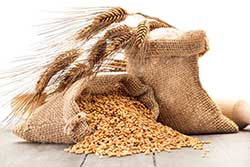
Google Trends began as a tool for bloggers and other curious folks to see what searches were, well, trending on Google in 2006.
In the years since, its capabilities have expanded widely.
Now, Google Trends has become a tool that most savvy marketers keep in their back pocket.
It offers a variety of new, fun, and useful features.
Let’s examine them step by step.
A Walk-Through of Google Trends
Explore Topics
 “Explore Topics” is the most useful feature for your site content.
“Explore Topics” is the most useful feature for your site content.
You can enter a topic/word and view how it trends over time by country, a subregion within that country (e.g., for the USA, it will narrow it down to each state, metro areas, or cities), or in the whole world.
Since different words have different meanings, you can also specify the category of a topic or just use the generic “search term” (basically, just the string of letters with no defined meaning).
And you can go deeper and specify whether you want a Web Search, Image Search, News Search, Google Shopping Search, or YouTube Search.
In addition, you can add several different terms and compare how popular they are.
There’s a lot to unpack in “Explore Topics,” so we’ll get more into the most effective ways to use it in the next section of this article.
Latest Stories and Insights
Head over to trends.google.com. The first section you’ll see, after the initial search bar and examples, is “Latest Stories and Insights.”

This is where Google rounds up the stories that people are currently searching for the most.
When you click “read more” on any story in this section, Google provides more insights and information about what exactly folks are looking for in relation to that story.
Clicking on the current “Coronavirus Search Trends, for example, brings this wealth of information…

… and clicking on any of the colored boxes digs deeper into the topic. Scrolling past the boxes brings you to the top questions currently being asked of that topic.
For bloggers, this section is especially useful — especially for evergreen events like “Independence Day.” Despite the year changing, folks will normally be searching for the same topics in relation to July 4th…

Try entering your niche keyword into the “Explore Topics” search bar, and dig down.
What questions do you see relating to your own niche? Can you answer them in a way that incorporates your “voice” — your own spin?
Recently Trending
Back on the main page, as you scroll past “Latest Stories and Insights,” you’ll reach “Recently trending.”
Here you can see what people are searching for the most on a given day — i.e., what is trending on Google.

When you click “More Trending Searches” at the bottom of that section, you can filter by Daily or Real-Time Search Trends and by country.
“Daily Search Trends” shows the trending searches for each given day along with the volume of searches.

Clicking on “Real-Time Search Trends,” takes you to highlighted stories that have been trending on Google in the past 24 hours. Filter these by category: business, entertainment, health, science / technology or sports.
Remember that for both “Daily Search Trends” and “Real-Time Search Trends,” you can change country. This is useful for targeting content more accurately to wherever your audience is.
Year in Search
Back at the main page again, Google rounds up the trending searches for each of the past 19 years.

This feature is not only a fun way to look back on the year that was: why not use it to spark inspiration for your own end-of-year article.
How to Use Google Trends for Your Website
The greatest use for Google Trends is the ability to discover how effective new pages might be, and to figure out ambiguous Site Concept Keywords.
There are a ton of different forms you can search for — Web content, images, news, Google shopping search, or YouTube search. For the sake of this article, we’re going to stick with Web search since we’re talking about Google Trends and how to use it for your website.
Let’s begin by delving into “Explore Topics” a little deeper…
Explore Topics
Return to the “Explore Topics” section on trends.google.com (the very first section).
 As an example, we’ll use “bread” as our chosen term and select “search term.” This is what Google trends understands as just a string of letters — it doesn’t worry what the actual meaning is.
As an example, we’ll use “bread” as our chosen term and select “search term.” This is what Google trends understands as just a string of letters — it doesn’t worry what the actual meaning is.
Enter “bread,” and use “Search term” in the drop down menu.
The difference in using “search term” v.s. the specific topic for the term (for example, “bread” with “food”) is that the “search term” will automatically include bread as a food in its results. But it will also include “bread” as a topic of money in its results.

In other words, if you simply look up a topic as a “search term,” it will bring up everything included/related to that word. So for example, banana bread would also be included.
On the next page, use “Worldwide” as the country, select the time frame you want to consider and in the final tab, use “Web Search.”
If we look at the past 5 years, bread has been fairly steady, even as a generic “search term.” It spikes in April 2020 due to its popularity as something to do from home during coronavirus lockdown.

Interest by Region
Following that graph, you can see where the term is most popular in the world.
You can sort by region or by city and then go deeper by clicking on the region or city and seeing what information folks want.
Region
Here we see that bread as a search term is most popular in…
- Trinidad & Tobago
- New Zealand
- Ireland
- United States
- Canada

If we click on Trinidad & Tobago, we can see the trend line, the regions in Trinidad & Tobago where it’s popular, and what information people want from Googling “bread” in Trinidad & Tobago…

City
You can do the same by narrowing down the search for “bread” to cities…

Related Topics
Related topics are terms that folks who are searching for your keyword are also looking for information about. They may be related to bread, or they may not! They’re useful as a way of inspiring lateral thinking.
These related topics are split into two categories: Rising and Top.
Rising vs. Top
Rising
“Rising” is based on Google Searches that have been performed recently. In essence, these are “trending” searches.
 Here we see 5 of the related rising topics are…
Here we see 5 of the related rising topics are…
- Ketogenic diet – Topic
- Dave’s Killer Bread – Company
- Dutch oven – Topic
- Almond meal – Topic
- Sourdough – Dough

A ketogenic diet is a low-carb diet, so it’s likely someone is looking for ways to make keto-friendly bread.
 The second is a popular organic bread company. Dutch ovens are used to make “24-hour bread,” almond meal is used to replace flour for low-carb bread, and sourdough is especially popular to grow while you’re isolating at home.
The second is a popular organic bread company. Dutch ovens are used to make “24-hour bread,” almond meal is used to replace flour for low-carb bread, and sourdough is especially popular to grow while you’re isolating at home.
These make sense because related topics are related to the topic, but don’t include the actual term/word in them.
If you want to rank for these “rising” keywords, you should dive deeper into the topic and then — start writing!
Top
“Top” topics are based on the average number of Google searches that have been performed in the last 12 months. These would be considered more evergreen than trending keywords.
The five related top topics for “bread” as a search term, are…
- Bread – Food
- Recipe – Topic
- Panera bread – Bakery company
- Banana – Fruit
- Banana bread- Bread
Because we looked up “bread” as a generic search term (not specifying food or any other category), it makes sense that the top related topic is “bread” under the food category.

These are topics you can write about which should bring you steady traffic for your blogging efforts.
Related Queries
Related queries are terms that folks are searching for that may or may not include your keyword in it.
Like related topics, these are also split into rising and top.
Again, related queries are keywords that you can write pages about, which will promote your website or blog on Google.
Rising vs. Top
Rising
Similar to the previous section, these are related queries that are becoming more popular.
- 90 second bread
- keto bread
- keto bread recipe
- 90 second keto bread
- chrissy teigen banana bread
These rising related queries go hand in hand with the rising related topics from before.

We see the demand for ketogenic breads and even a celebrity’s recipe for banana bread (Chrissy Teigen is an American supermodel, John Legend’s wife, and famous for tweeting about her banana bread).
Again, these are keywords that folks are recently searching for a lot! If you want to start ranking for those, you better start writing now!
Top
These are top related queries, so again, they’re slightly more evergreen search queries.
- bread recipe
- panera bread
- panera
- banana bread
- banana bread recipe

These queries are also closely related to the top related topics from above.
These top related queries could also make decent evergreen pages.
For example, you could have a page where you write about banana bread, then a related page with a traditional banana bread recipe and another with Chrissy Teigen’s banana bread recipe (along with her infamous tweets begging the public for their ripe bananas so she could bake her banana bread!).
Explore Topics and Site Concept Keywords
Below, you can see bread as a generic search term compared with Bread, the food. (Simply add “Bread” to the “Add comparison” tab.)

The numbers you see represent popularity, 100 being the most popular.
During the week of April 5-11 2020, the generic search term is 69 vs. 59 for the food.
 It’s quite close, but not exact. Where does that difference come from?
It’s quite close, but not exact. Where does that difference come from?
Adding in “money,” as a third comparator, it soars above both the search term and food at a popularity of 78.
That number went into calculating 69 for food, the generic search term. Taking 78 out of the value for the food’s term lowered it to 59. In other words…
If you have an ambiguous search term, this can prove very useful.
This is most useful for evaluating your niche or site concept keyword, which represents tier 1 in your 3-tier website structure. Why?
- Site concept keywords are where ambiguity is most likely to happen. After all, once you add “recipes” to “bread” to get “bread recipes,” there aren’t many recipes for money. Adding a second word to any word is going to reduce ambiguity tremendously (or eliminate it altogether).
- Your site concept keyword is your most important search term. If this process cuts in half your original demand for the site concept keyword, your evaluation of your tier 2 pages becomes that much more important.
- Your decision to stick with your site concept may remain a “go” since most of your traffic and monetization opportunities will come from your pages and posts and your long-tail keywords. That is, unless you choose a niche that’s tight enough that you have a good chance at a #1 spot for your site concept keyword.
When making your final site concept selection, you blend in data from all your possible pages, including…
- Are there enough good evergreen pages (what SBI! refers to as “Tier 2s”) to fill out a reasonable-sized site?
- Do these pages each have enough good posts (in SBI! terms, “Tier 3s”) to fill them out?
This leads us to another useful feature on Google Trends…
Granularity
 With evergreen pages there will, as mentioned, rarely be ambiguity problems. As we said, “bread recipes” (or “banana bread” or “ketogenic bread” and so on) is not going to have any other meaning due to the specificity of the term.
With evergreen pages there will, as mentioned, rarely be ambiguity problems. As we said, “bread recipes” (or “banana bread” or “ketogenic bread” and so on) is not going to have any other meaning due to the specificity of the term.
So even if the site concept keyword according to Google Trends is not as good as you might have thought, you may still be able to generate enough traffic, with good enough monetization opportunities, simply because the detailed data Trends offers is enough to reassure you.
Of course, being able to check demand and supply with a reliable tool such as Solo Build It!’s Brainstorm it! adds an important extra layer of reassurance!
Using Google Trends to Improve Your Site Content: Conclusion
 So, there you have it. If you’re not sure where to go next for your blog content, Google Trends is an interesting tool to investigate.
So, there you have it. If you’re not sure where to go next for your blog content, Google Trends is an interesting tool to investigate.
Not just interesting — this information is coming straight from the horse’s mouth!
Combined with a reliable keyword research tool such as Brainstorm It! which provides specific numbers upon which to make decisions, you’ll have no difficulty in finding relevant, interesting topics to inspire you, and thrill your readers.

Latest posts by Yuki Evoy (see all)
- Quit Your Day Job in 5 Steps: How I Did It - December 15, 2022
- How to Use AI for Your Blog: Artificial Intelligence 101 - November 10, 2022
- Why a Side Hustle is the New Job Security (And How to Start Yours) - July 26, 2022

